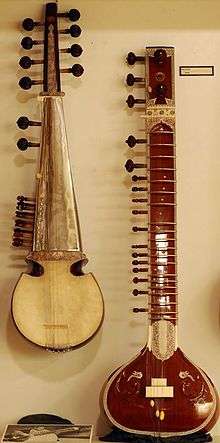Rudra veena
Rudra veena (also spelled Rudra vina, and also called Bīn in North India), is a large plucked string instrument, originating from the Indian subcontinent, used in Hindustani classical music, one of the major types of veena played in Indian classical music.
Rudra veena | |
| String instrument | |
|---|---|
| Other names | Rudra vina, Been, Bin |
| Classification | String instrument |
| Musicians | |
| Ustad Shamshuddin Faridi Desai (1936 - 2011), Bande Ali Khan (1826 - 1890), Ustad Abid Hussain Khan, Rajab Ali Khan Rudra Veena, Mohammed Khan Faridi, Jamaluddin Khan, Murad Khan Rudra Veena, Krishnarao Kholapure, Anant Bedekar, Asad Ali Khan (1937 - 2011), Asit Kumar Banerjee, Jyoti Hegde, R.V. Hegde (b. 1953), Bindu Madhav Pathak (1935 - 2004), Shrikant Pathak, Bahauddin Dagar (b.1970), Carsten Wicke (b. 1970), Peter Row, Rudra Veena (1944-2018), Dattatreya Rama Rao Parvatikar (1916 - 1990), Hindraj Divekar, Naubat Khan, Omrao Khan, Wazir Khan (Rampur), Zia Mohiuddin Dagar (1929 - 1990), Zahid Khan | |
| More articles or information | |
| Veena, Saraswati veena, Vichitra veena, Chitra veena | |
It has a long tubular body made of wood or bamboo with a length between 54 and 62 inches. Two large, round resonators, made of dried and hollowed gourds, are attached under the tube. Twenty-four brass-fitted raised wooden frets are fixed on the tube with the help of wax. There are 4 main strings and 3 chikari strings.
As Rudra is a name for the Hindu god Shiva, rudra vina literally means "the veena dear to Shiva". Shiva is also said to have created the Rudra veena, inspired by his wife, Parvati. It is an ancient instrument rarely played today. The rudra veena declined in popularity in part due to the introduction in the early 19th century of the surbahar, which allowed sitarists to more easily present the alap sections of slow dhrupad-style ragas. In the 20th century, Zia Mohiuddin Dagar modified and redesigned the rudra veena to use bigger gourds, a thicker tube (dandi), thicker steel playing strings (0.45-0.47 mm) and closed javari that. This produced a soft and deep sound when plucked without the use of any plectrum (mizrab). The instrument was further modified as the shruti veena by Lalmani Misra to establish Bharat's Shadja Gram and obtain the 22 shrutis.[1]
Gallery
.jpg) Veena Maharaj Dattatreya Rama Rao Parvatikar(1916-1990) playing Rudra Veena
Veena Maharaj Dattatreya Rama Rao Parvatikar(1916-1990) playing Rudra Veena Bahauddin Dagar playing rudra veena in the South Indian posture
Bahauddin Dagar playing rudra veena in the South Indian posture
See also
- Mohan Veena
